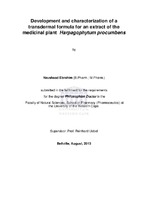| dc.description.abstract | The skin is the largest and most readily accessible organ of the body. The stratum corneum forms the outermost layer of the skin, which functions as a barrier to the external environment and regulates the passage of molecules across the skin. Drug delivery across the skin offers advantages over other routes of administration, bypassing the hepatic first pass metabolism, maintaining therapeutically effective drug levels, and improved patient compliance. Currently, there is a strong trend in the use of plant materials and extracts for medicinal purposes. Devil’s Claw (Harpagophytum procumbens) is a medicinal plant located
in many regions throughout Southern and South Africa. It is used for its anti-inflammatory and analgesic properties with the harpagoside and harpagide components present reported to be responsible for these properties. Its activity has been reported to be as a result of the direct and indirect inhibition of Cyclooxygenase- 2 enzyme (COX-2). Efforts to improve the permeation of synthetic conventional compounds are constantly investigated, and great improvements of these formulations have led to very effective formulation of transdermal dosage forms such as anti-inflammatory drugs. The same should
be possible for medicinal plants. Optimal permeation across the skin requires a drug to possess lipophilic as well as hydrophilic properties. Research suggests that a drug should have an aqueous solubility of more than 1 mg/ml and an octanol-water partition coefficient (log P) between 1 and 2 to optimally penetrate the skin (higher values indicating increased lipophilicity). Compounds not
possessing these characteristics may be facilitated across the skin by the introduction of permeation enhancers in the formulation that include Azone® and sodium dodecyl sulphate xvi (SDS). The main aims of this study were to make an extract of Harpagophytum procumbens and to determine the direct COX-2 inhibition activity of this extract and further to formulate this extract into a pharmaceutical gel, with permeation enhancers that maintains its COX-2 enzyme inhibition qualities after transdermal penetration. The analytical techniques verified the existence of a harpagide and harpagoside components in the crude Harpagophytum procumbens extract and they were quantified in the extract at 3% and 1% respectively. COX-2 inhibition by the Harpagophytum procumbens extract was determined by a direct enzyme inhibition study and quantified by means of measuring the production of the product formed by the enzyme over a time interval in the presence of excess enzyme substrate. Crude Harpagophytum procumbens extract demonstrated a greater COX-2 enzyme inhibition than pure harpagide and harpagoside individually and combined. This indicated the existence of compounds in the extract contributing to this synergistic effect. This was reflected in the IC50 values indicating that the Harpagophytum procumbens crude extract had the lowest IC50 values concentration when compared to the harpagide and harpagoside. Octanol-PBS partition coefficient (log D) experiments were performed with various permeation enhancers and gels with varying combinations in order to determine the changing partitioning properties of harpagide and harpagoside. The octanol-PBS partition coefficient (log D) experiments indicated that harpagoside had a higher log D value than harpagide. The addition of permeation enhancers resulted in changes in the partition co-efficient of the
marker compounds. The permeation enhancer, Azone®, resulted in the smallest reduction of Log D for harpagoside and the largest increase in Log D compared to other permeation enhancers tested for harpagide. xvii When the 2 marker compounds were formulated into different gel formulations (hydroxypropyl cellulose, Carbopol Ultrez 21® and Pluronic®), harpagide had the largest increase in Log D with the Carbopol Ultrez 21® gel. Harpagoside had the largest increase in
the hydroxypropyl cellulose gel.Combinations of gel formulations with permeation enhancers were tested. The 2 best performing permeation enhancers in hydroxypropyl cellulose gel were SDS and Azone®. These compounds resulted in the largest increase in lipophilic partitioning for harpagide and harpagoside compound and higher values were achieved with SDS. Following the partition co-efficient determination, permeation studies with synthetic membranes were performed with the selected enhancer/gel formulations using Franz diffusional cells.
The permeation (flux) across the hydrophobic synthetic membrane (Sil-Tec®) indicated flux of 27.1μg.cm-2.h-1 for harpagoside and 156.0 μg.cm-2.h-1 for harpagide in the hydroxypropyl cellulose gel. Incorporation of Azone® in the hydroxypropyl cellulose formulation resulted in an enhancement ratio (ER) of 14 for harpagoside. The hydroxypropyl cellulose gel with the permeation enhancers (Azone® and SDS) did not result in enhancement of permeation of the harpagide.
Permeation of harpagoside and harpagide across the hydrophilic synthetic membrane (Tuffyrn®) yielded flux values of 537.1 μg.cm-2.h-1 and 101.1μg.cm-2.h-1 respectively in the Gel formulations. The Gel formulation containing Azone® and SDS, resulted in similar flux across this membrane compared to the formulation consisting of the Gel only, with the Azone® containing formulation resulting in lower flux for harpagide. Transdermal permeation was measured through excised female human abdominal skin using Franz diffusion cells.
xviii Flux values for harpagoside and harpagide were 18.4 μg.cm-2.h-1 and 5.0 μg.cm-2.h-1 respectively when the crude extract was in the hydroxypropyl cellulose gel tested on human skin. Formulation of the crude extract in hydroxypropyl cellulose gel including Azone® and SDS permeation enhancers resulted in enhancement of 8 and 7 respectively for harpagide. Azone® increased the flux of harpagoside 14 times in the same hydroxypropyl cellulose gel
formulation. The SDS had very little effect. The enhancement ratios achieved with the human skin was higher than that of the synthetic membranes. Post transdermal COX-2 inhibition activity studies were performed with the Azone® Gel formulation after it permeated across the human skin membrane to determine to what extent
inhibitory activity of the crude extract was maintained. The crude drug retained its direct COX-2 inhibitory activity after permeation across the human skin with 77% inhibitory activity. | en_US |

